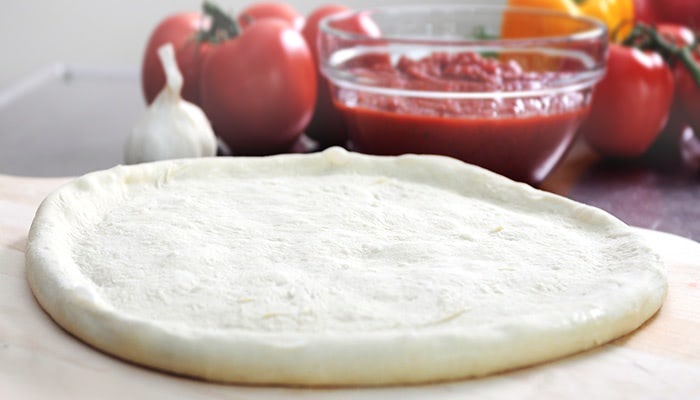
Proofing, also known as “proving,” frozen pizza dough can be tricky at first, as you need to balance time management, temperature, and tools while judging color, size, and texture. Once you master these skills, you’ll be deep in delicious dough and enjoy a streamlined kitchen.
Read on for the ultimate guide to proofing pizza dough balls. We’re looking at dough balls specifically, as many restaurants prep their pizza this way.
How to Proof (Prove) Pizza Dough Balls
- Get your cooler ready. Check your refrigerator’s temperature using a thermometer (other than the one installed in the cooler). Is it above 38°F? Consider lowering the temperature to 34°F. Your dough balls should be between 34° and 40°F during the proofing process. Keep the refrigerator door closed to avoid temperature fluctuations.
- Get sheet pans on deck. Sheet pans, in contrast to fiberglass dough totes, allow for better airflow.
- Take dough balls out of the freezer. Wrap each dough ball in clingwrap (plastic film) and place them on your sheet pans, about two inches apart. Wrapping dough balls in clingwrap prevents crusting.
- Stack your dough. Keep the trays off the floor (a pallet or dolly works great) and remember the rule of three: keep a 3-inch gap between stacks and between the trays and cooler wall. After the dough has reached 40°F, stacks can be moved closer together.
How Long to Proof (Prove) Pizza Dough
The minimum amount of required proofing time for pizza dough is 24 hours. A 48-hour proof is a better option, and a 72-hour proof is ideal. Wondering how long pizza dough lasts? Look no further.
How to Tell if Pizza Dough is Proofed
During Preparation:
- Color: When frozen, dough balls are off-white. When properly proofed, dough balls turn yellow.
- Size: Frozen dough balls are fairly small. When proofed correctly, dough balls expand to 1.5 to 2 times their original size.

- Consistency: Properly risen dough “holds” an indentation when gently poked.
During Baking:
Well-proofed pizza dough will lead to baked crust with …
- Color: a white crumb (interior) and golden-brown surface.
- Size: an even, consistent shape—no major lumps, bumps, or flat sections.
- Flavor: a full-bodied, yeasty bread flavor.
Can You Over-Proof Pizza Dough? Can You Under-Proof It?
Yes, you can under-proof and over-proof pizza dough.
- Under-proofed pizza dough will be nearly white, tight and springy, and when gently poked, the indentation made by your finger will bounce back.
- Over-proofed pizza dough will be gray, have a loose consistency, and display a rippled surface. It may also lose gas and collapse when you poke it.
Check out AK Pizza Crust’s Corporate Chef, Luke, as he shows the lifecycle of a dough ball from freezer to fully proofed. The video also shows how distinctive dough balls look when they’re frozen, vs. well-proofed or over-proofed.
Can I Use Under/Over-Proofed Pizza Dough?
Hey, we’re not here to boss you around, but no … we really don’t recommend using under/over-proofed pizza dough.
Under-proofed dough won't brown properly or crisp up. It will also be extremely bubbly in the oven, to the point where you have to constantly watch for and pop crust bubbles. Over-proofed pizza dough tastes good and will get crispy, however, it will be flat and lifeless.
Proofing pizza dough using established best practices is the only reliable way to achieve the flavorful, perfectly risen crust of top-quality pizza. Frozen dough balls make obtaining that consistent quality easier and faster and could save your operation money in the process.
How Do I Determine How Much Frozen Pizza Dough to Proof?
Production Planning
Before each dough-making session, a manager should review pizza sales data to project dough consumption for the desired timeframe. That number, less the amount of dough on hand and with the addition of a 10% buffer, equates to how much dough should be taken out of the freezer.
Rotation and First-In-First-Out (FIFO)
Refrigerated dough should be tagged, showing when it was taken out. Then, stock should be rotated in the cooler so the oldest is always used first. Without proper rotation, dough will end up over- or under-risen.
Are Proofing and Proving Pizza Dough the Same Thing? Why Do People Use Those Terms Interchangeably?
If you got to this point and are still wondering about proofing vs. proving, we got you. “Proofing" and "proving" pizza dough are the same thing—both terms refer to how dough rises before it is shaped, topped, and baked. The term "proofing" is more commonly used in the U.S., while "proving" is often used in the U.K.
Regardless of the terminology, the proofing/proving process ensures that dough is light, airy, and flavorful.
Tasty, Reliable Dough Balls: The Proof is in the Profits
We’re here to make the storage, prep, and serving of fantastic pizza dough and crusts easy, waste-free, and efficient. Let’s find the right pizza crust products that perform—and create profits—for your operation.
This blog was originally published on February 11, 2016, but updated and republished on February 7, 2025


![Blog: Hand Stretching Pizza Dough: 8 No-Fail Steps [VIDEO] Hand Stretching Pizza Dough: 8 No-Fail Steps [VIDEO]](https://www.akcrust.com/hs-fs/hubfs/Blog_Images/stretching-dough-ball.jpg?width=265&height=151&name=stretching-dough-ball.jpg)

